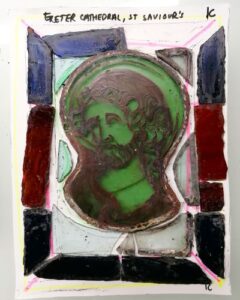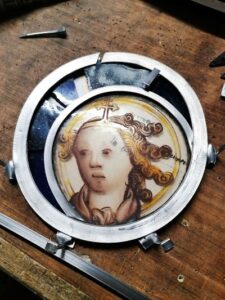The Cathedral’s medieval stained glass is back in place after being removed for the first time in several centuries.
While the building was closed to visitors due to coronavirus restrictions, the priceless windows in the cathedral’s east end underwent extensive specialist conservation work to help preserve them for future generations.
 The windows, some of which are nearly 700 years old, had suffered extensive deterioration from centuries of wet weather.
The windows, some of which are nearly 700 years old, had suffered extensive deterioration from centuries of wet weather.
Repeated exposure to moisture had begun to erode the glass, while the leadwork had bowed and distorted, leaving the future of the windows in jeopardy.
The work was carried out by specialist conservators, Holy Well Glass, at their workshop in Wells, Somerset, where they applied the same centuries-old techniques and materials used in the original construction of the windows.
For Holy Well Glass’ director Jack Clare, it has been a painstaking but rewarding project:
“We’re a family-run business with decades of experience in conserving the windows of cathedrals and royal palaces across the UK. But the east end windows at Exeter are incredibly old, and we had to be especially careful throughout the whole process.
“In some cases we had to completely dismantle the glass from the leadwork, which has meant carefully recording, removing and reassembling over 12,000 pieces.”
To prevent further deterioration, many of the original decorated panels have been reinstalled behind an outer layer of clear glass to protect them from the weather – a special conservation technique that is invisible when viewed from ground level.
“It’s been an amazing project, and hopefully the work we’ve done will preserve these stunning windows for centuries to come.”
 The project has been funded by the Heritage Stimulus Fund, part of the Government’s Culture Recovery Fund, administered by Historic England and the Church of England’s Archbishop’s Council, along with additional support from The Friends of Exeter Cathedral charity.
The project has been funded by the Heritage Stimulus Fund, part of the Government’s Culture Recovery Fund, administered by Historic England and the Church of England’s Archbishop’s Council, along with additional support from The Friends of Exeter Cathedral charity.
It is support that has been sorely needed as the Cathedral has continued for over a year without much of its usual income, due to coronavirus restrictions.
Chris Sampson, Exeter Cathedral’s clerk of works, manages the building’s continuous schedule of conservation and maintenance projects. For him and his team, the space and quiet of lockdown has provided a unique opportunity:
“Our visitors, community and worship are at the heart of who we are and why we’re here – and of course the loss of income from being closed due to coronavirus has been a heavy blow for us.
“But an empty cathedral does at least enable us to make a huge amount of progress with essential conservation work. Much of this work has been waiting for years to find space in a lively Cathedral calendar, so we’re delighted to have completed this section of window conservation in time for our returning summer visitors to enjoy.”
 As well as providing bright and beautiful windows for visitors to admire, Exeter Cathedral maintains a keen sense of duty to look after the ancient building on behalf of the people of Devon. As the Dean of Exeter, The Very Revd Jonathan Greener concludes:
As well as providing bright and beautiful windows for visitors to admire, Exeter Cathedral maintains a keen sense of duty to look after the ancient building on behalf of the people of Devon. As the Dean of Exeter, The Very Revd Jonathan Greener concludes:
“Exeter Cathedral is of course an important historical building – in fact one of the most significant cathedrals in Europe. But it is also a precious part of the heritage of the people of Devon. It’s been their cathedral for nearly a thousand years.
“We are determined to do everything we can to preserve this special place for generations to come. And this stained glass conservation project is an important part of that goal, achieved thanks to the support of the Department for Digital, Culture, Media & Sport, Historic England, Archbishops’ Council and The Friends of Exeter Cathedral.”
The Cathedral is now open to visitors every day. Opening times and further information to help plan a visit can be found here.